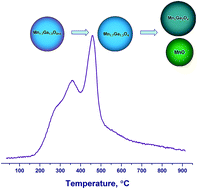The subject of this study was the content of oxygen in mixed oxides with the spinel structure Mn1.7Ga1.3O4 that were synthesized by coprecipitation and thermal treatment in argon at 600–1200 °C. The study revealed the presence of excess oxygen in “low-temperature” oxides synthesized at 600–800 °C. The occurrence of superstoichiometric oxygen in the structure of Mn1.7Ga1.3O4+δ oxide indicates the formation of cationic vacancies, which shows up as a decreased lattice parameter in comparison with “high-temperature” oxides synthesized at 1000–1200 °C; the additional negative charge is compensated by an increased content of Mn3+ cations according to XPS. The low-temperature oxides containing excess oxygen show a higher catalytic activity in CO oxidation as compared to the high-temperature oxides, the reaction temperature was 275 °C. For oxides prepared at 600 and 800 °C, catalytic activity was 0.0278 and 0.0048 cm3 (CO) per g per s, and further increase in synthesis temperature leads to a drop in activity to zero. The process of oxygen loss by Mn1.7Ga1.3O4+δ was studied in detail by TPR, in situ XRD and XPS. It was found that the hydrogen reduction of Mn1.7Ga1.3O4+δ proceeds in two steps. In the first step, excess oxygen is removed, Mn1.7Ga1.3O4+δ → Mn1.7Ga1.3O4. In the second step, Mn3+ cations are reduced to Mn2+ in the spinel structure with a release of manganese oxide as a single crystal phase, Mn1.7Ga1.3O4 → Mn2Ga1O4 + MnO.

